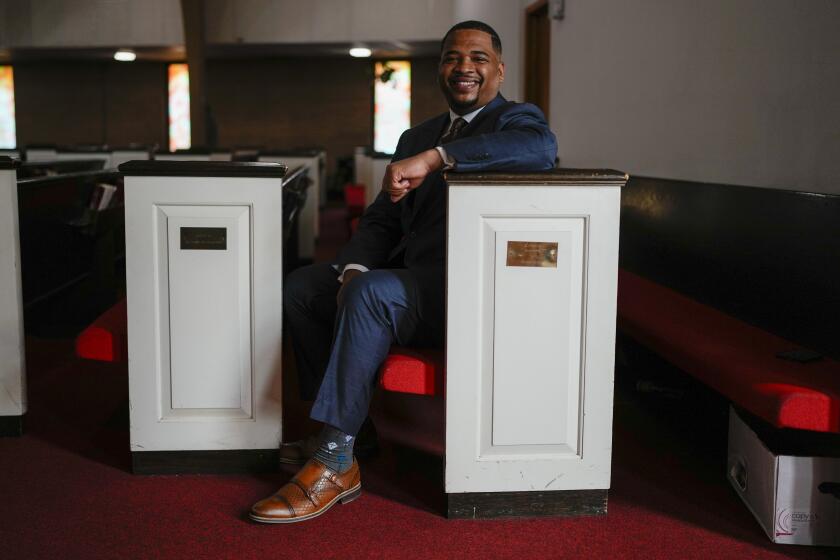Water Drops, Mayor Hopeful
A patchwork system of newly repaired levees and overworked pumps made visible progress Tuesday in flushing out Hurricane Katrina’s floodwaters from the river city’s sodden streets. But medical authorities warned that contaminated water would pose a health risk until it could be fully drained over the next three months.
President Bush and congressional leaders grappled with upcoming decisions about how to proceed with disaster relief and recovery plans as the White House again tried to allay the barrage of criticism over the federal government’s initial response to Katrina.
Bush said he would mount his own inquiry and added that Vice President Dick Cheney would tour the storm-pulverized region Thursday to “assess our recovery efforts.” But the president resisted an immediate investigation, saying: “I’m going to find out over time what went right and what went wrong.”
As White House officials worked on a new round of emergency aid that could funnel up to $40 billion to stricken Gulf Coast states, Congress began pursuing its own inquiries. Sen. Susan Collins (R-Maine), chairwoman of the Senate Government Affairs Committee, said the panel would investigate the federal government’s performance. “Government at all levels failed,” she said.
On a day when fires again erupted across New Orleans and the official count of flood victims in Louisiana and Mississippi ticked upward to 253, there were signs of recovery in the thunderous spray of water rushing back into Lake Pontchartrain.
“I’m starting to see rays of light,” said New Orleans Mayor C. Ray Nagin.
Army engineers and public works officials said tons of sandbags, metal sheets and a rock and gravel mix now plugged a 200-foot breach in the 17th Street Canal and a similar gaping hole in the London Avenue Canal.
A week ago, swollen by Katrina’s rains, the flood walls burst and the lake spilled into the city, inundating up to 90% of New Orleans’ neighborhoods. Clapboard houses, sprawling estates and housing projects alike were submerged -- and authorities fear thousands drowned.
After a helicopter survey of the city in the morning, Nagin reported that floodwaters were slowly draining from neighborhoods. Standing water covered only 60% of the city, he said. “Even in areas where the water was up to the rooftops, we are now starting to see part of the buildings.”
Most of the city’s 22 pumping stations were knocked out by the flood, but at least three were up and running Tuesday, officials said. Other stations were being scoured of an infusion of trash and debris while a temporary system of portable pumps droned through the day, spewing floodwater back into the lake. Crews worked to get one large station -- which Nagin called “the big daddy” -- operating soon, along with a critical power plant on Carrollton Avenue.
Army Corps of Engineers spokesman Dan Hitchings said it would take 24 to 80 days to pump out New Orleans and its surrounding parishes, an area that sits like a basin below sea level.
That timetable, Army officials said, depends on the amount of rainfall, the status of the pumping stations and the crush of debris, which includes crumbled brick and concrete, severed tree trunks, trash, sewage and corpses. The most worrisome variable is another hurricane -- and hurricane experts kept a close watch on two distant storms, Nate and Maria, and a new tropical weather system that formed Tuesday off Florida’s southeast coast.
Fresh water could begin flowing into the city again as early as today, Nagin said. But he cautioned that officials doubt it will be drinkable. The 1,600-mile-long pipe system that delivers the city’s water is clotted with silt, pollution and bacteria -- and the foul runoff is not potable even if boiled.
“We have to flush the system,” Nagin said.
Without water, there was no pressure for hoses carried by firefighters who battled four blazes that burst Tuesday through houses across the city. National Guard helicopters dredged water from polluted lakes and canals to douse the flames, and firetrucks trekked to Algiers, across the Mississippi River about seven miles from downtown, to fill up there from a still-working hydrant system.
Fire Chief Charles Parent said his beleaguered units have responded to “several large fires a day.” On Tuesday, gray smoke rolled from a row of houses in the city’s historic Garden District of Uptown.
“There’s nobody out there to call 911,” Parent said.
Parent said the department has been supplemented by firefighters from across the nation, including 300 from New York and 50 from Illinois.
Firefighters and search teams have risked sniper fire in recent days. At least one armed suspect was arrested Tuesday after a search helicopter flying over the city Monday night was targeted by gunfire from Algiers.
Alerted by a radio report, a federal firearms team patrolling the area saw a man aiming a gun out an apartment window. Agents surrounded the unit and arrested the suspect. Inside, agents found two handguns and ammunition hidden beneath a mattress. U.S. Atty. Jim Letten said federal agents charged Wendell L. Bailey, 20, with committing federal crimes of targeting aircraft and illegally possessing a handgun. He could face 30 years in prison if convicted.
Federal agent Mark Chait said Bureau of Alcohol, Tobacco, Firearms and Explosives “special response” teams are patrolling New Orleans neighborhoods, targeting those who take potshots at aircraft, firefighters, medical teams and soldiers.
New Orleans Police Supt. Eddie Compass said more than 500 officers were still missing. “We only have 1,200 officers accounted for out of 1,700,” Compass said. “Some might have been incapacitated because of the storm. Some of our officers were trapped in eight feet of water. Hopefully they are not victims.”
Later Tuesday, Compass said the “large number of unaccounted for could be dead or someplace where they can’t be reached. We just don’t know.” But Compass said he did not believe that any officers had abandoned their posts.
In addition to the 83 bodies recovered so far in southern Louisiana, 170 dead have been counted in Mississippi, officials said. Louisiana medical authorities said 59 bodies are at a federal morgue operating in a warehouse in St. Gabriel. Another 22 bodies are in Jefferson Parish and two in St. Charles Parish. Earlier this week, officials also acknowledged that St. Bernard Parish officials had reported as many as 100 bodies waiting on community docks.
The low count of dead so far is only “a sign of the reporting process,” said Bob Johannessen, a spokesman for the Department of Health and Hospitals.
None of the bodies has been released to family, Johannessen said. Federal Disaster Mortuary Operational Response teams are taking DNA samples and cataloging fingerprints and other information to identify the victims. “At some point, families can bring in a DNA sample or something else to see if there’s a match to identify a loved one,” he said.
Health officials are concerned about the lingering effects of hundreds and possibly thousands of corpses decomposing in the floodwaters. Traces of the bacterium E. coli have also been found in the floodwaters, Nagin said.
Both the filthy city water and polluted standing floodwaters can be incubators for disease. After touring the Gulf Coast region over the weekend, U.S. Surgeon General Dr. Richard Carmona said Tuesday that contaminated water is likely the cause of an increase of several bacterial-related illnesses, including diarrhea in children evacuated from flood zones.
“Epidemiologists are tracking them closely to see if there’s a common source,” Carmona said in an interview with CNN.
Specialists from the National Institutes of Health began staffing a field hospital in Meridian, Miss., for hurricane evacuees. The facility has been outfitted with 250 beds and is equipped to treat a wide range of ailments.
In New Orleans and elsewhere in southern Louisiana, searchers trolling in flat boats and helicopters continued to find people alive in flooded houses, carrying them out of attics and off rooftops.
Many were elderly, delirious and severely dehydrated, Nagin said. Coast Guard and military helicopters and water-borne search teams have rescued more than 32,000 people in Louisiana since Katrina hit last week, said David Passey, a spokesman with the Federal Emergency Management Agency.
Search teams also still were confronting residents refusing to leave.
The mayor issued an order Tuesday night giving law enforcement the right to forcibly remove people from their homes if they wouldn’t leave with rescuers.
The order does not mean that officers will barge into people’s houses and carry them out -- not yet, anyway. It was intended, officials said, to send a message that the mayor is serious when he says the city -- at least everything north of the Mississippi River -- needs to be evacuated.
“We’re not pulling people out of their houses,” New Orleans Police Capt. Marlon Defillo said. “We’re trying to appeal to their common sense. If you stay out there, you can die.”
FEMA’s management of rescue missions and relief aid continued to spark controversy. Dr. Walter Maestri, chief of emergency operations in Jefferson Parish, said: “We’re all angry, including me, because promises made were not promises kept. We were told we would be on our own for 48 hours and then the cavalry would arrive. But it didn’t....People feel cheated.”
A day after Bush thanked emergency workers in Baton Rouge as part of his second tour of the hurricane-damaged region, Louisiana Gov. Kathleen Babineaux Blanco told state residents that her staff was working as “a well-oiled machine” with federal partners.
But in an interview with CNN, Blanco spoke openly for the first time about the Bush administration’s back-channel attempt Friday to wrest away her authority over National Guard troops operating in the state.
“They gave me a very complicated proposition to look at it,” she said. “It didn’t help our effort.” Blanco added that she opposed the move because she was “concerned about giving up law enforcement authority.”
Blanco said that she and Nagin “were both asking for the same thing. We wanted troops, we wanted water, we wanted helicopters. We asked early in the week. We asked for everything available from the federal government. We got it from the National Guard. The federal effort was a little slow in coming.”
Gold reported from New Orleans and Hart from Baton Rouge, La. Times staff writers Solomon Moore also reported from New Orleans and Stephen Braun, James Gerstenzang and David Willman reported from Washington.
More to Read
Start your day right
Sign up for Essential California for news, features and recommendations from the L.A. Times and beyond in your inbox six days a week.
You may occasionally receive promotional content from the Los Angeles Times.







